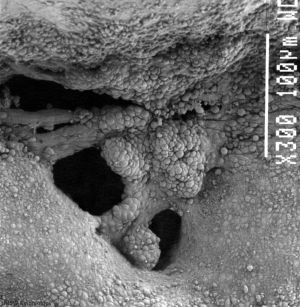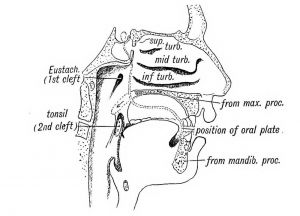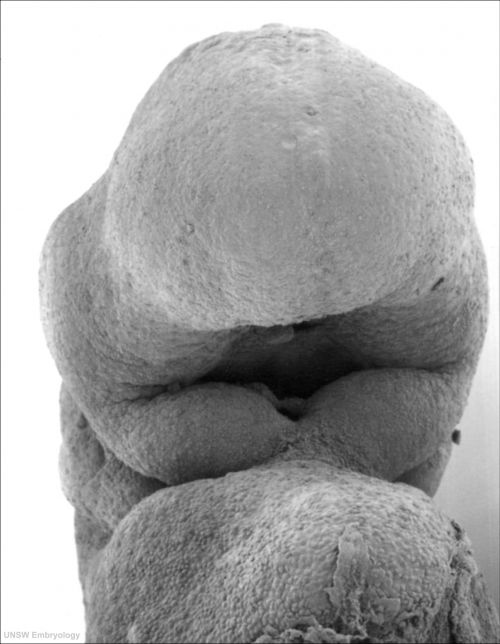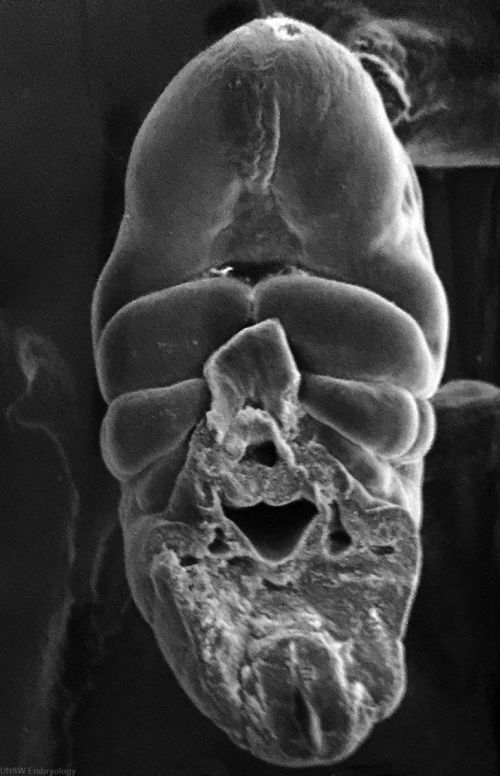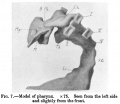Buccopharyngeal membrane
| Embryology - 28 Apr 2024 |
|---|
| Google Translate - select your language from the list shown below (this will open a new external page) |
|
العربية | català | 中文 | 中國傳統的 | français | Deutsche | עִברִית | हिंदी | bahasa Indonesia | italiano | 日本語 | 한국어 | မြန်မာ | Pilipino | Polskie | português | ਪੰਜਾਬੀ ਦੇ | Română | русский | Español | Swahili | Svensk | ไทย | Türkçe | اردو | ייִדיש | Tiếng Việt These external translations are automated and may not be accurate. (More? About Translations) |
Introduction
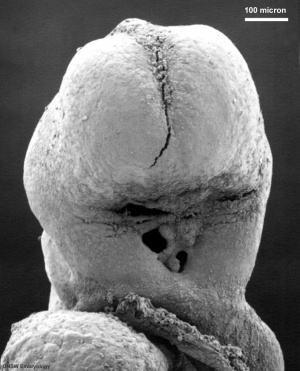
The buccopharyngeal membrane (Latin, bucca = cheek) or oral membrane, forms the external upper membrane limit (cranial end) of the early gastrointestinal tract (GIT). This membrane region first develops in the trilaminar embryo (week 3) during gastrulation and lies above the cranial end of the notochord. The "membrane" quality comes from being composed of only ectoderm and endoderm, without a middle (intervening) layer of mesoderm.
The membrane lies at the floor of the ventral depression (stomadeum) where the oral cavity will open. The membrane will break down during week 4 (GA week 6) to form the initial "oral opening" of the pharynx of the foregut. After this time the oral cavity and foregut are open to then Template:Amniotic cavity. The membrane region at the lower end of the gastrointestinal tract is the cloacal membrane that will break down at a later stage of development.
Some Recent Findings
|
| More recent papers |
|---|
|
This table allows an automated computer search of the external PubMed database using the listed "Search term" text link.
More? References | Discussion Page | Journal Searches | 2019 References | 2020 References Search term: Buccopharyngeal Membrane Development | Oral membrane | Persistent Buccopharyngeal Membrane |
| Older papers |
|---|
| These papers originally appeared in the Some Recent Findings table, but as that list grew in length have now been shuffled down to this collapsible table.
See also the Discussion Page for other references listed by year and References on this current page. |
Buccopharyngeal Membrane Timeline
The key developmental changes in the buccopharyngeal membrane that can be morphologically observed on the embryo surface occur during week 4 (GA week 6) of human embryonic development.
| Week: | 1 | 2 | 3 | 4 | 5 | 6 | 7 | 8 |
| Carnegie stage: | 1 2 3 4 | 5 6 | 7 8 9 | 10 11 12 13 | 14 15 | 16 17 | 18 19 | 20 21 22 23 |
- Human Buccopharyngeal Membrane Timeline Gallery (Week 4)
Stage 10 Embryo
A ventral view scanning EM embryo cranial end (day 21, 4 to 5 somites) showing early cardiac tube lying beneath brain fold. Between these two structures is where the stomedeum and buccopharyngeal membrane will form. Note that the pharyngeal arches are not yet visible.
Stage 11 Embryo
A ventral view of the embryo head region (Carnegie stage 11, week 4, 25 days, 20 somite pairs) showing the buccopharyngeal membrane breaking down and opening the gastrointestinal tract to the amnion.
Note the position at the "floor" of the stomedeum and relative to the first pharyngeal arch and triangular shape. Midline crack in head is an artefact.
| Bright Field | Scanning EM | Scanning EM |
|---|---|---|

|

|

|
Stage 12 Embryo
A ventral view of the embryo head region (Carnegie stage 12, week 4, 26 days, 25 somite pairs, CRL 5 mm). Note by this stage, one day later, the buccopharyngeal membrane has been entirely lost.
Stage 13 Embryo
A ventral view of the embryo head region (Carnegie stage 13, week 4, CRL 5.5 mm).
Abnormalities
Persistent Buccopharyngeal Membrane
A persistent buccopharyngeal membrane is a very rare abnormality with only (2009) 23 reported cases in the literature. [2] There are a variety of clinical repair techniques.[3]
Persistence of the buccopharyngeal membrane can lead to several orofacial abnormalities:
- choanal atresia - narrowing of the rear opening of the nasal cavity.
- oral synechiaes - fibrous bands between the mucosal surfaces of the upper and lower alveolar ridges.
- cleft palate - failure of the maxillary shelves to fuse to form the palate.[4]
A mouse model has shown that hedgehog mediates persistence of the buccopharyngeal membrane.[5]
1p36 Deletion Syndrome
The 1p36 deletion syndrome comprises a phenotypic presentation that includes central nervous system, cardiac, craniofacial, and airway anomalies. A single patient study identified a persistent buccopharyngeal membrane and unidentifiable larynx.[6]
Animal Models
| Species | Reference |
|---|---|
| chicken | Waterman RE & Schoenwolf GC. (1980)[7] |
| frog | Watanabe K, Sasaki F & Takahama H. (1984)[8] Houssin NS. etal. (2017)[1] |
| Hamster | Waterman RE. (1977)[9] |
| mouse | Poelmann RE. etal. (1985)[10] |
| Salamander | Takahama H, Sasaki F & Watanabe K. (1988)[11] |
References
- ↑ 1.0 1.1 Houssin NS, Bharathan NK, Turner SD & Dickinson AJ. (2017). Role of JNK during buccopharyngeal membrane perforation, the last step of embryonic mouth formation. Dev. Dyn. , 246, 100-115. PMID: 28032936 DOI.
- ↑ Verma SP & Geller K. (2009). Persistent buccopharyngeal membrane: report of a case and review of the literature. Int. J. Pediatr. Otorhinolaryngol. , 73, 877-80. PMID: 19342107 DOI.
- ↑ Bent JP, Klippert FN & Smith RJ. (1997). Management of congenital buccopharyngeal membrane. Cleft Palate Craniofac. J. , 34, 538-41. PMID: 9431473 DOI.
- ↑ Pillai KG, Kamath VV, Kumar GS & Nagamani N. (1990). Persistent buccopharyngeal membrane with cleft palate. A case report. Oral Surg. Oral Med. Oral Pathol. , 69, 164-6. PMID: 2304741
- ↑ Tabler JM, Bolger TG, Wallingford J & Liu KJ. (2014). Hedgehog activity controls opening of the primary mouth. Dev. Biol. , 396, 1-7. PMID: 25300580 DOI.
- ↑ Ferril GR, Barham HP & Prager JD. (2014). Novel airway findings in a patient with 1p36 deletion syndrome. Int. J. Pediatr. Otorhinolaryngol. , 78, 157-8. PMID: 24290305 DOI.
- ↑ Waterman RE & Schoenwolf GC. (1980). The ultrastructure of oral (buccopharyngeal) membrane formation and rupture in the chick embryo. Anat. Rec. , 197, 441-70. PMID: 7212297 DOI.
- ↑ Watanabe K, Sasaki F & Takahama H. (1984). The ultrastructure of oral (buccopharyngeal) membrane formation and rupture in the anuran embryo. Anat. Rec. , 210, 513-24. PMID: 6524693 DOI.
- ↑ Waterman RE. (1977). Ultrastructure of oral (buccopharyngeal) membrane formation and rupture in the hamster embryo. Dev. Biol. , 58, 219-29. PMID: 885288
- ↑ Poelmann RE, Dubois SV, Hermsen C, Smits-van Prooije AE & Vermeij-Keers C. (1985). Cell degeneration and mitosis in the buccopharyngeal and branchial membranes in the mouse embryo. Anat. Embryol. , 171, 187-92. PMID: 3985368
- ↑ Takahama H, Sasaki F & Watanabe K. (1988). Morphological changes in the oral (buccopharyngeal) membrane in urodelan embryos: development of the mouth opening. J. Morphol. , 195, 59-69. PMID: 3339635 DOI.
Reviews
Chen J, Jacox LA, Saldanha F & Sive H. (2017). Mouth development. Wiley Interdiscip Rev Dev Biol , 6, . PMID: 28514120 DOI.
Articles
Houssin NS, Bharathan NK, Turner SD & Dickinson AJ. (2017). Role of JNK during buccopharyngeal membrane perforation, the last step of embryonic mouth formation. Dev. Dyn. , 246, 100-115. PMID: 28032936 DOI.
Arcand P & Haikal J. (1988). Persistent buccopharyngeal membrane. J Otolaryngol , 17, 125-7. PMID: 3385865
Additional Images
Historic
Glossary Links
- Glossary: A | B | C | D | E | F | G | H | I | J | K | L | M | N | O | P | Q | R | S | T | U | V | W | X | Y | Z | Numbers | Symbols | Term Link
Cite this page: Hill, M.A. (2024, April 28) Embryology Buccopharyngeal membrane. Retrieved from https://embryology.med.unsw.edu.au/embryology/index.php/Buccopharyngeal_membrane
- © Dr Mark Hill 2024, UNSW Embryology ISBN: 978 0 7334 2609 4 - UNSW CRICOS Provider Code No. 00098G
